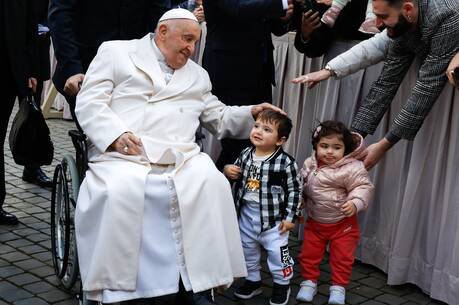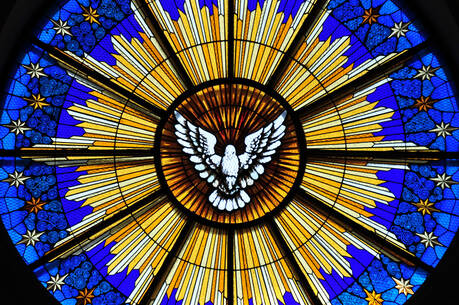The evening sun is perceived as still setting when in fact it has already dipped below the horizon. Something similar happens in other contexts. A historic period, for example, may actually have ended before the people it shaped quite realize it has gone.
An instance of this is suggested almost casually by a few general statistics in a news release issued by the National Catholic Educational Association two months ago. The prestige of U.S. Catholic elementary and secondary schools is probably greater today than ever. In the big cities they are generally considered better than public schools. All the same, there are fewer of these schools than there were 40 years ago, because there are fewer sisters to run them. Financial pressures are constant when most teachers are laypeople, who must in justice be paid a fair wage.
The N.C.E.A. bulletin reported that in the academic year 2002-3, the total U.S. Catholic school enrollment was 2,553,277. The 6,785 elementary/middle schools had 1,906,870 students; the 1,215 high schools had 646,407. Together these schools had a full-time equivalent professional staff of 163,374. Of this number, 94.4 percent were laymen and laywomen and 4.2 percent were sisters.
Even people who have not been paying attention can see that these overall numbers and this distribution of personnel point to an epochal change in American Catholic education. Over the last two centuries, American Catholics built an educational network that eventually extended from nursery schools to colleges and universities. Historians are likely to rate this as one of the great religio-cultural achievements of the first two millennia of Catholic Christianity. In its own way, it stands alongside such accomplishments as the civilizing effect of Benedictine monasticism in the western stretches of the old Roman empire or the building of 13th-century Gothic cathedrals or the breaking out of 19th-century Europe to carry the Gospel around the world.
By 1965, the year in which the Second Vatican Council held its fourth and final session, there were in the United States 10,931 elementary schools (almost all of them parish schools) that enrolled 4,566,809 children—nearly twice the 2002-3 enrollment. There were also 2,465 high schools (diocesan, parochial and independent) with 1,095,519 students.
At the elementary level, the establishment and maintenance of this system had been largely the work of women—the members of several hundred religious orders and congregations. In the 19th century, almost all the teachers in the Catholic lower schools were sisters, and as late as 1965 sisters still outnumbered lay teachers by more than two to one in elementary schools. The Official Catholic Directory for 1965 reported that there were then 104,314 sisters teaching in Catholic schools somewhere along the line from kindergarten to graduate seminar. The directory for 2003 notes that the corresponding number for this year is 7,389. It is not fanciful to conclude that an era has ended.
For decades, hundreds of young women entering religious congregations were dispatched almost at once from the novitiate to classrooms rocking with the exuberance of 60 or more children. When the school day was over, the sisters returned to the convent for afternoon prayer, supper, “recreation” (an hour of lively conversation often accompanied by some useful needlework), and then preparation for the next day’s classes.
On Saturdays, the sisters took off for nearby universities, where they were accumulating credits toward a bachelor’s degree. On Sundays, they monitored the parish Mass for children and taught catechism to public school students. There was never a time when even half the Catholic youth from 5 to 17 were in Catholic schools.
Often enough, when these sisters were well into middle age, they could still be found during the summertime in their voluminous habits on the campus of a Fordham University or a St. Louis or a Notre Dame taking more courses or working for a master’s degree.
If some of these overburdened women have been portrayed in waspish memoirs as less agreeable than Medusa, most sisters are remembered with affection touched with awe. At how many dinner tables were not arguments concluded by the untrumpable dictum “Sister says...”?
What sister said may not always have been quite correct, but by and large she and her colleagues set generations of children on the way to becoming both good Christians and good citizens. In this world those women were nearly anonymous, and now their mortal remains lie under identical headstones in cemetery plots on motherhouse grounds. But for the work they did, they will surely, as the prophet said, be “shining like stars for all eternity” (Dn 12:6).








Your editorial “Valiant Women” told us that in the last 40 years the number of Catholic schools and their enrollments have dropped by 50 percent. That is more than 10 percent per annum. The decline is ongoing. Why? Because the schools of the past were staffed mostly by religious women, who worked a day and a half, seven days a week for nothing but minimal keep. Lay people cannot and will not do that.
The cost of running good quality Catholic schools that will accommodate all our Catholic children, not just a precious few, is simply out of reach. So our schools are closing one by one.
What can we do? We must go back to the bedrock of religious education in any time, in any land, in any religion—the temple and the home. For us, that is the Catholic family and the Catholic parish. The family authority and the parish authority must work together to catechize their children. That system is known as the Confraternity of Christian Doctrine. There is no way that we can succeed without it.
Yet how are children to be helped today who may be “getting a crappy education,” to use the words of the mayor of Washington, D.C., Anthony A. Williams? I will not address this question, although I do recognize that the quality of education in some public schools (more than we would like) deserves deep attention. I do not think, however, that the legislation you describe as “a small, five-year pilot program” justifies your support.
I am glad that Cardinal Theodore McCarrick does believe in public education and is working with civic leaders to improve it in Washington, D.C. I applaud his efforts, but he may be an exception. I see no similar efforts here in South Florida. In fact, in Florida there is a Catholic Education Foundation whose specific objective is to push for public vouchers. It does so on the premise that Catholic parents should have the right to choose individually where to use their tax dollars for their children’s education. Note that these vouchers are not intended for “low-income families” only. Rather, the foundation rides a Republican bandwagon that tries to introduce public vouchers to fix every real and assumed ill in the public schools.
Your earlier editorial “Valiant Women” (9/22) quite rightly focused on the formidable role religious sisters played in the historical development of Catholic education in the United States. That history was made possible by the low compensation paid to the sisters. Is it too simple and naive to suggest that as the cost of Catholic education increases and the number of its schools decreases, the official Catholic support for public vouchers for use in private (including religious) schools increases?
You describe charter schools as being “publicly funded but not publicly controlled.” I do not think this is an accurate description. The charter school idea was intended to relieve the charter school from many of the burdens that constrain the public school, and thus allow the charter school to develop new ways of teaching. In Florida, however, the concept has become debased, since the charter school movement has been captured by for-profit corporations that act as subcontractors for those granted the charter. Those holding the charter are frequently former public officials and people with political and financial ties to current, as well as former, public officials. Perhaps you should examine what charter schools are really doing, since the program for Washington, D.C., that your editorial supports includes money set aside for charter schools.
So much of Catholic school history has been due to its teachers and administrators, first the religious sisters (and brothers) and now members of the laity. Yet you criticize Senate Democrats because they “treasure the good will of the powerful teachers unions, which detest vouchers.” Why did you not say “the good will of powerful teachers”? Do we no longer see a working group and their unions as one and the same? Could we not equally say that “Senate Republicans, like the Republican party generally at all levels, treasure the good will of all those fundamentally opposed to public education, and see public vouchers as one means to undermine it”?
How did sisters live on $3,500 to $4,000 a year? By careful management. By abstemiousness. Grapefruit for dessert on Sunday. Oranges twice a week for breakfast.
Physicians and dentists were good to us, usually not charging for care, which was generous and efficient. Some merchants and some universities offered religious discounts. For a time on the railroads “sisters and squaws” rode free.
Sisters, few in number, still serve as diocesan chancellors, as advisers to nongovernmental organizations at the United Nations and, while the official church still lags behind, as pastoral associates.
A nonagenarian could ramble on. Sisters made me what I am today, a happy nun for 70 years with a satisfying career to look back on and a blessed eternity ahead, comfortable with the knowledge that good lay people are discharging now the functions that were formerly left to sisters.
It is a magnificent and well-deserved tribute to all sisters everywhere to whom the church in our country is so indebted. In the name of the Dominican Sisters of Sparkill, I express our/their gratitude.
To celebrate Mass each day and to see in the chapel balcony so many faithful sisters in wheelchairs or using walkers; to sit at table and listen to so many reminisce cheerfully about their years of ministry; to be the beneficiary of countless lived homilies; all this is a special privilege for this aging Dominican chaplain.
Though the sisters may no longer be engaged in active apostolates because of age and poor health, this is still a rewarding and effective ministry of presence.
To this day the Catholic faithful can still profit and grow spiritually because “Sister says....”
What a shame it is that the general press does not give as much coverage to the extraordinary stories of century-old generosity as they have, for example, to the recent movie “The Magdalene Sisters.”
The editorial mentioned these religious now lie beneath identical simple tombstones, and, indeed, many of them do. However, over 40,000 of them are over age 70 still very much alive and last year required over $848 million in care. The median age of women religious is now 69 and that of men religious is 63. With their Social Security benefits only 3.5% of the average retiree's benefit and their very inadequate retirement savings, the struggle to meet rising care costs is tough.
So, I ask you to keep these generous pioneers and benefactors of our Catholic heritage in mind. Not all are "pushing up the daisies".
Sister Andree Fries, CPPS Retirement Fund for Religious
The editorial mentioned these religious now lie beneath identical simple tombstones, and, indeed, many of them do. However, over 40,000 of them are over age 70 still very much alive and last year required over $848 million in care. The median age of women religious is now 69 and that of men religious is 63. With their Social Security benefits only 3.5% of the average retiree's benefit and their very inadequate retirement savings, the struggle to meet rising care costs is tough.
So, I ask you to keep these generous pioneers and benefactors of our Catholic heritage in mind. Not all are "pushing up the daisies".
Sister Andree Fries, CPPS Retirement Fund for Religious